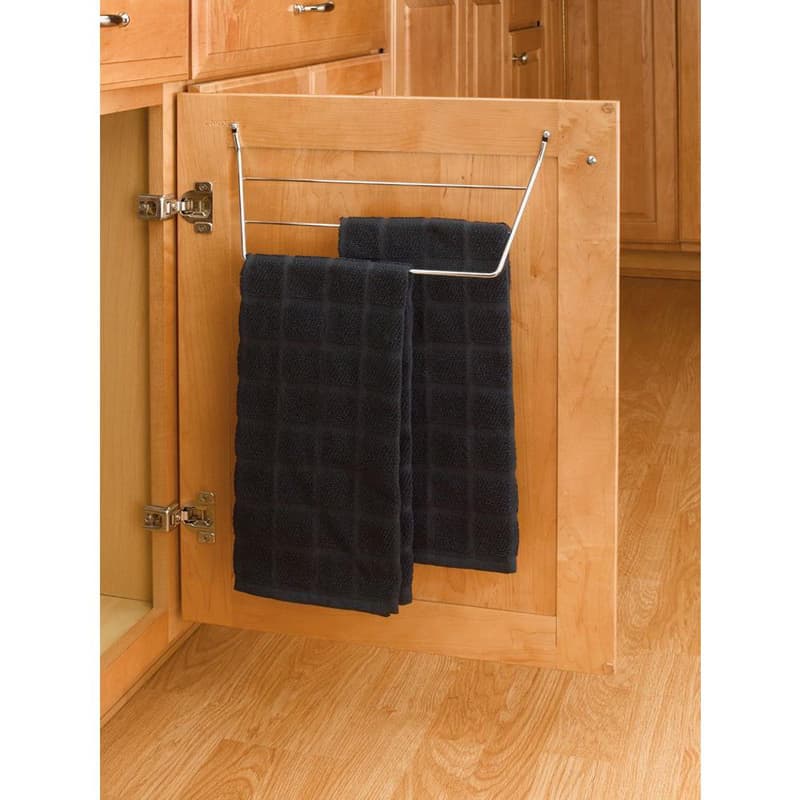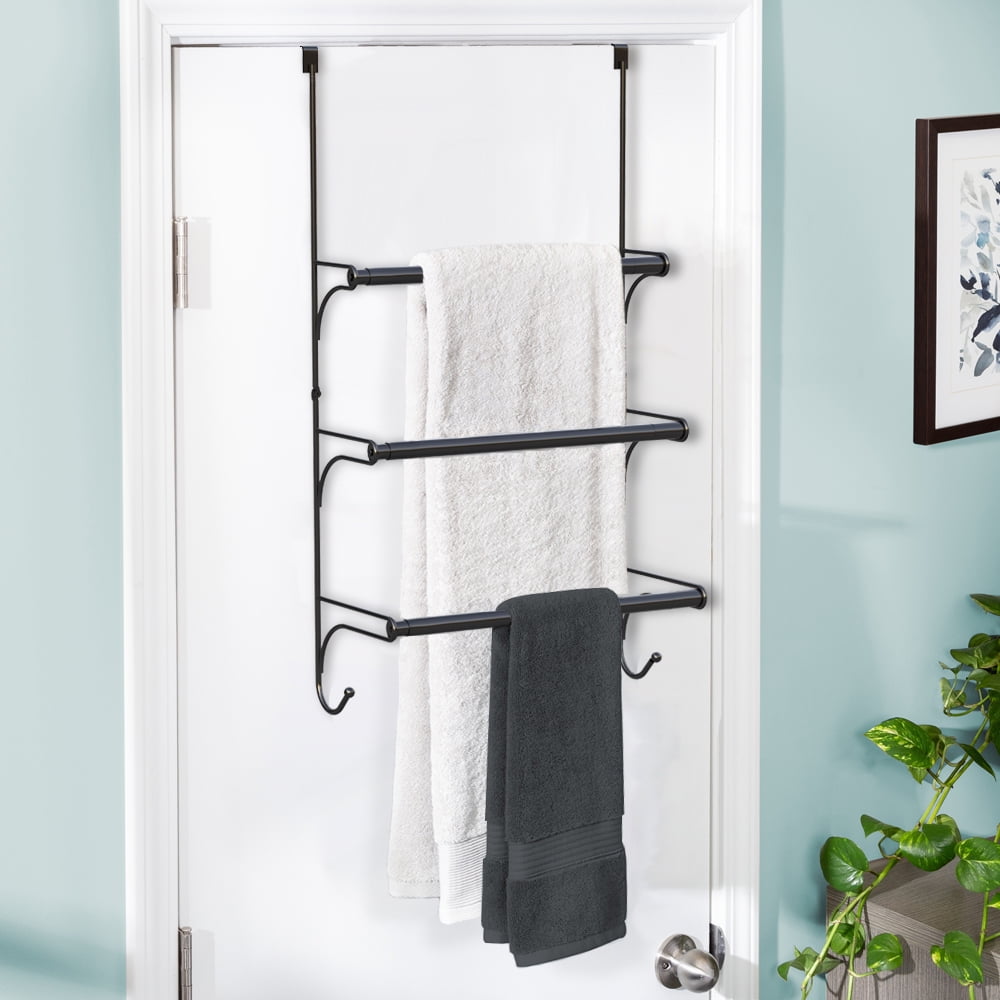Cabinet Door Towel Rack Design Considerations

A well-designed cabinet door towel rack seamlessly blends functionality and aesthetics, adding convenience and a touch of elegance to your kitchen or bathroom. This section delves into the critical design considerations that contribute to a successful cabinet door towel rack.
Materials Used in Construction
The material used in a cabinet door towel rack significantly impacts its durability, aesthetics, and overall cost.
- Stainless Steel: Renowned for its strength, rust resistance, and sleek appearance, stainless steel is a popular choice for cabinet door towel racks. It withstands high temperatures and moisture, making it suitable for both kitchens and bathrooms. However, stainless steel can be expensive compared to other options.
- Aluminum: Aluminum offers a lightweight and corrosion-resistant alternative to stainless steel. Its affordability and versatility make it a popular choice for many towel rack designs. However, aluminum may not be as durable as stainless steel, especially in high-traffic areas.
- Plastic: Plastic towel racks are the most budget-friendly option, often featuring vibrant colors and diverse designs. While lightweight and easy to clean, plastic may not be as durable as metal options and can become brittle over time, especially when exposed to extreme temperatures.
Mounting Methods
The mounting method chosen for a cabinet door towel rack determines its stability and ease of installation.
- Adhesive: Adhesive mounting is a convenient option, requiring no drilling or screws. It’s ideal for lightweight towel racks and surfaces that cannot be drilled. However, adhesive mounting may not be suitable for heavy towel racks or surfaces with textured finishes. The strength of the adhesive is also crucial, as a weak adhesive can lead to the rack detaching from the cabinet door.
- Screws: Screw mounting offers a more secure and long-lasting option, especially for heavier towel racks. It requires drilling holes in the cabinet door, which may not be feasible for all surfaces. However, screw mounting provides the most reliable attachment, ensuring the towel rack remains firmly in place.
- Magnetic: Magnetic mounting is a discreet and damage-free option for attaching towel racks to metal cabinet doors. However, the strength of the magnets is crucial, as weak magnets may not hold the towel rack securely, especially with a heavy towel load.
Space Efficiency and Aesthetics
A well-designed cabinet door towel rack optimizes space and complements the overall aesthetic of your kitchen or bathroom.
- Maximize Space: Consider the available space on your cabinet door and choose a towel rack that fits seamlessly without obstructing other features or hindering the opening and closing of the door. Opt for a rack with multiple bars or tiers to accommodate multiple towels.
- Aesthetic Appeal: Select a towel rack that complements the existing décor and finishes in your kitchen or bathroom. Consider the style, color, and material of the rack to ensure it blends seamlessly with the overall aesthetic.
Size and Weight Capacity
The size and weight capacity of a cabinet door towel rack are critical factors to consider, ensuring it can safely hold your towels and prevent any damage to the cabinet door.
The weight capacity of a towel rack is typically determined by the material used, the mounting method, and the overall design.
- Size: Measure the available space on your cabinet door to determine the appropriate size for the towel rack. Consider the length, width, and depth of the rack to ensure it fits comfortably and accommodates the desired number of towels.
- Weight Capacity: The weight capacity of a towel rack should be sufficient to accommodate the weight of the towels you intend to hang. Consider the thickness and material of the towels you typically use, and choose a rack with a weight capacity that exceeds the expected load.
Cabinet Door Towel Rack Installation and Maintenance

Installing a cabinet door towel rack is a simple yet effective way to add functionality and storage to your kitchen or bathroom. This guide provides a comprehensive approach to installation and maintenance, ensuring your towel rack remains in tip-top shape for years to come.
Installation Process, Cabinet door towel rack
The installation process is relatively straightforward and involves a few essential steps. Here’s a breakdown of the steps involved:
- Gather the Necessary Tools: You’ll need a few basic tools for installation, including a screwdriver (Phillips head and flathead), a pencil, a measuring tape, and a level. Some installations may require a drill with a drill bit appropriate for the cabinet door material.
- Choose the Location: Select a location on the cabinet door that is easily accessible and provides ample space for towel hanging. Consider the door’s hinge side and ensure the rack doesn’t interfere with the door’s opening and closing.
- Mark the Installation Points: Use the pencil and measuring tape to mark the exact positions on the cabinet door where the towel rack will be attached. Use a level to ensure the markings are straight and level.
- Pre-Drill Holes (if necessary): If the cabinet door material is hard, such as solid wood or laminate, pre-drilling holes with a drill bit slightly smaller than the screws will prevent splitting the wood.
- Attach the Towel Rack: Align the towel rack with the marked points and secure it to the cabinet door using the provided screws. Tighten the screws securely, ensuring the rack is firmly attached.
Preventing Rust and Corrosion
Maintaining your cabinet door towel rack is crucial to prevent rust and corrosion. Regular cleaning and maintenance are key to extending the lifespan of your rack.
- Regular Cleaning: Wipe down the towel rack with a damp cloth and mild detergent regularly to remove dirt, grime, and moisture. Avoid harsh chemicals or abrasive cleaners that can damage the finish.
- Drying After Use: After each use, pat the towel rack dry with a clean cloth to prevent moisture buildup, which can lead to rust and corrosion.
- Consider Protective Coatings: For metal towel racks, applying a thin layer of clear sealant or wax can provide an extra layer of protection against rust and corrosion.
Installation Challenges
Different cabinet door types and materials can present unique challenges during installation. Here are some considerations:
- Glass Doors: Installing a towel rack on a glass cabinet door requires special attention. Adhesive-backed towel racks or racks with suction cups are often preferred, as drilling into glass can be challenging and potentially damaging.
- Thin Doors: If the cabinet door is thin, it may be difficult to find screws that are long enough to securely attach the towel rack without going through the door. Consider using shorter screws or alternative mounting methods, such as adhesive-backed hooks or clips.
- Solid Wood Doors: Solid wood doors are generally more durable and easier to drill into. However, pre-drilling holes is recommended to prevent splitting the wood.
Troubleshooting Common Issues
While cabinet door towel rack installation is generally straightforward, occasional issues may arise. Here are some common troubleshooting steps:
- Loose Towel Rack: If the towel rack is loose, tighten the screws securely to ensure a firm attachment. If the screws are too short, consider using longer screws or alternative mounting methods.
- Rust or Corrosion: Rust and corrosion can be prevented by following the maintenance tips mentioned earlier. If rust or corrosion is already present, use a rust remover and apply a protective coating to prevent further damage.
- Damaged Cabinet Door: If the cabinet door is damaged during installation, consider repairing the damage or replacing the door.
Cabinet Door Towel Rack Styles and Applications

Cabinet door towel racks offer a practical and stylish solution for maximizing space and adding a touch of elegance to your home. Their versatility allows them to seamlessly integrate into various room settings, enhancing functionality and aesthetics.
Diverse Styles of Cabinet Door Towel Racks
Cabinet door towel racks come in a wide array of styles, catering to diverse aesthetic preferences and design schemes. These styles can range from sleek and modern to rustic and traditional, seamlessly blending with the overall decor of your home.
- Contemporary: Characterized by clean lines, minimalist designs, and often featuring sleek metallic finishes like chrome or brushed nickel. These racks are ideal for modern kitchens and bathrooms with a minimalist aesthetic.
- Rustic: Embracing natural materials like wood or wrought iron, often with distressed finishes or antique accents. These racks complement farmhouse-style kitchens, bathrooms, and laundry rooms, adding a touch of warmth and character.
- Minimalist: Emphasize simplicity and functionality, typically featuring slim profiles and subtle designs. They are perfect for creating a clean and uncluttered look in any space.
Applications of Cabinet Door Towel Racks
Cabinet door towel racks find practical applications in various rooms throughout the home, offering a convenient and space-saving solution for towel storage.
- Kitchen: Used for hanging dish towels, hand towels, or tea towels, keeping them readily accessible while saving valuable counter space.
- Bathroom: Ideal for hanging hand towels, washcloths, or even small bathrobes, maximizing space and minimizing clutter.
- Laundry Room: A practical addition for hanging damp towels, allowing them to air dry quickly while keeping them off the floor.
Visual Representation of a Cabinet Door Towel Rack
Imagine a modern bathroom with sleek white cabinetry. A chrome cabinet door towel rack is mounted on the inside of a cabinet door, offering a convenient and stylish way to hang hand towels. The rack’s sleek design complements the bathroom’s modern aesthetic, adding a touch of sophistication while maximizing space. The towel rack’s chrome finish reflects light, adding a touch of brightness to the space. This design demonstrates the functionality and aesthetics of a cabinet door towel rack in a modern bathroom setting.
Challenges of Integrating a Cabinet Door Towel Rack
While cabinet door towel racks offer numerous benefits, their integration into existing cabinet door designs may present certain challenges.
- Door Thickness: The thickness of the cabinet door needs to be considered when selecting a towel rack. Some racks are designed for specific door thicknesses, while others are adjustable to accommodate different sizes.
- Cabinet Hardware: The placement of cabinet door handles or knobs may limit the installation options for a towel rack. Careful planning is crucial to ensure that the rack does not interfere with existing hardware.
- Existing Decor: The style of the cabinet door towel rack should complement the existing decor of the room. Consider the overall design scheme and choose a rack that blends seamlessly with the surrounding elements.
A cabinet door towel rack is a great way to maximize space in your bathroom, especially if you have limited counter or shelf space. If you’re looking for a more comprehensive storage solution, consider a prepac elite 54 wall cabinet , which offers ample storage for towels, toiletries, and other bathroom essentials.
You can then use a cabinet door towel rack to keep frequently used towels within easy reach.
A cabinet door towel rack is a practical addition to any kitchen, providing a convenient spot to hang dish towels. If you’re looking to enhance the aesthetic appeal of your cabinets, consider incorporating wood appliques for kitchen cabinets.
These decorative accents can complement the towel rack and add a touch of elegance to your kitchen’s design. By combining functional elements with decorative touches, you can create a kitchen that’s both stylish and efficient.
